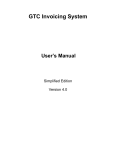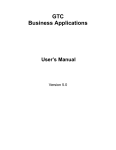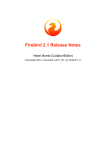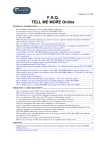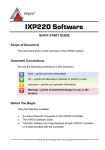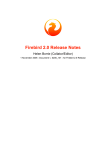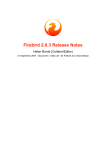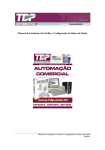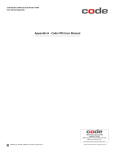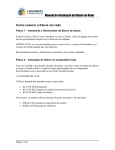Download GTC Business Applications for SME User`s Manual
Transcript
GTC Accounting System User’s Manual Simplified Edition Version 4.0 Publisher: Glorious Technology Company Limited COPYRIGHT © 1997-2007 Glorious Technology Company Limited. All rights reserved. All GTC brands and product names are trademarks or registered trademarks of Glorious Technology Co., Ltd. Other product names are trademarks or registered trademarks or their respective holders. Printed in China LICENSE AGREEMENT This software is protected by copyright law and international copyright treaty. Therefore, you must treat this software just like a book, except that you may copy it onto a computer to be used and you may make archive copies of the software for the sole purpose of backing up our software and protecting your investment from loss. The software may be moved from one computer to another, so long as there is no possibility of it being used by more than one person at a time. ADDING USERS You may add users by paying for a separate software package for each user you wish to add. You may also add users by purchasing a site-license, so long as the number of persons who are able to use the software at one time is not more than the number of authorized users specified in our product or license. TRANSFERRING THE SOFTWARE You may transfer all of your rights to use the software to another person, provided that you transfer to that person all of the software, diskettes (if applicable), and documentation provided in this product (including this statement), and transfer or destroy all copies in any form. Remember, once you transfer the software, you no longer have any right to use it, and the person to whom it is transferred may use it only in accordance with the copyright law, international treaty, and this statement. If you transfer this product to another person, the new user have no right to use our free support service even this product under free warranty period. If you have purchased an upgrade version of the software, it constitutes a single product with the software the you upgraded. For example, the upgrade and the software the upgraded cannot both be available for use by two different people at the same time, and cannot be transferred separately, without written permission from Glorious Technology Co., Ltd. Except as provided in this statement, you may not transfer, rent, lease, lend, copy, modify, translate, sublicense, time-share, or electronically transmit or receive the software, media, or documentation. LIMITED WARRANTY 1. Glorious Technology Co., Ltd. provides 90 days free hot-line support from the original purchase date. 2. Glorious Technology Co., Ltd. warrants the product provided by Glorious Technology Co., Ltd. to be free of defects in materials and workmanship for a period of 60 days from the original purchase date. 3. The entire and exclusive liability and remedy for breach of this limited warranty shall be limited to replacement of defective media or documentation and shall not include or extend to any claim for or right to recover any other damages, including but not limited to, loss of profit, data, or use of the software or special, incidental or consequential damages, or other similar claims, even if Glorious Technology Co., Ltd. has been specifically advised of the possibility of such damages. 4. This warranty is invalid when the product has been damaged through misuse, negligence, accident, computer virus and natural calamities. 5. Glorious Technology Co., Ltd. is not responsible for the data which create or produce by the software. 6. Glorious Technology Co., Ltd. makes no representation or warranty that the software or documentation are "error-free", or meet any user's particular standards, requirements or needs. 7. Glorious Technology Co., Ltd. provides no warranty at all to any person, other than the Limited Warranty provided to the original purchaser of this product. 8. Installing and using this software indicate the purchaser and the users' acceptance of above terms and license agreement. The invalidity or unenforceability of any provisions of this License Agreement shall not affect the remaining provisions hereof. Contents Chapter 1 1.1 1.2 1.3 1.4 Installation Before Installation Execute Installation Program Installation Steps Network version Installation 1-1 1-1 1-1 1-5 Chapter 2 2.1 2.2 2.3 2.4 2.5 2.6 Functions and Operations Multi Company Control System First time to the Application Exit Choosing and Searching Records Function Keys Export reports by e-mail 2-1 2-4 2-4 2-4 2-6 2-6 Chapter 3 3.1 3.2 3.3 3.4 3.5 3.6 3.7 3.8 3.9 3.10 General Files Management Company Information File Currency File System Numbers File Chart of Accounts File Accounting Period Control Accounts User Security System Set Up Remark File User Log Control 3-1 3-1 3-2 3-3 3-4 3-5 3-7 3-8 3-9 3-10 Chapter 4 4.1 4.2 4.3 4.4 Transfer Voucher Header Detail Footer Other Functions 4-1 4-2 4-2 4-3 Chapter 5 5.1 5.2 5.3 5.4 Bank Reconciliation Header Detail Footer Printing 5-1 5-1 5-2 5-2 Chapter 6 6.1 6.2 6.3 6.4 6.5 6.6 Utilities Backup Data Restore Data Adjust Closing Stock Value Year End Database Tools Transaction Auditor 6-1 6-2 6-3 6-4 6-4 6-4 Chapter 7 7.1 7.2 7.3 7.4 Firebird Installation Firebird’s system requirements Installation in MS Windows 32 bit operation system Install Firebird server under Unix/Linux Key points about Firebird / Interbase 7-1 7-2 7-10 7-11 Chapter 8 8.1 8.2 8.3 8.4 8.5 Appendix How to enhance the performance of GTC Applications Notes to send reports by e-mail Information about MS Windows 2000 Information about Linux Questions and Answers 8-1 8-1 8-2 8-3 8-4 Chapter One Chapter 1 1.1 Installation Installation Before Installation Before installation, please check the followings: a) b) c) d) e) f) Hardware requirements -Intel Pentium 200Mhz or above CPU (Intel Pentium II 450Mhz CPU recommended) -64MB RAM or above -HDD space for GTC applications is about 100MB. The space for data depends on the volume of your data. 20MB HDD space for data is recommended. -800x600 resolutions Operating System -Microsoft Windows 98SE, ME, 2000(SP2), XP Home Edition or XP Professional Edition (SP1) -Please use Administrator authority to log in when the Operating System is MS Windows 2000 or XP Folders for GTC applications and Data -Default folder for GTC applications is c:\gtc\gsa40. Normally, GTC applications should be installed in local hard disk, either single user version or network version, to enhance the performance. -If the data will be shared in network, the permission of data folder for Read, Write, Add and Delete should be assigned. Create a company data -Set up Account Period carefully when create a company data. Account Period can’t be modified after the company data created. -Set up some basic information for Chart of Accounts and Accounting Period etc. Install Firebird/Interbase Server GTC application is a SQL database application. Firebird/Interbase server must be installed. Firebird 1.0.0.796 (or newer version) or Interbase 6.5 (or newer version) is required. Firebird/Interbase server and any databases you create or connect to must reside on a hard drive that is physically connected to the host machine. You cannot locate components of the database server, or any database, on a mapped drive, a file system share or a network file system. If Firebird/Interbase is installed in another computer, following information should be collected: i) Server name/Computer name or IP address: e.g. FirstServer or 192.168.1.1 ii) Data folder and database’s file name in server: the default file name of database is GBSI.FDB. For example, c:\gtc\gsa40\data\gbsi.fdb. iii) Firebird/Interbase’s user name and password: any tools which need to connect Firebird/Interbase’s database file requires this information. The user name of administrator of Firebird/Interbase is SYSDBA and password is masterkey. For security reasons, we suggest to change the password of SYSDBA immediately. If Firebird 1.5 or above is installed in Linux operating system, the installer will generate a random SYSDBA password and store that in 1-1 GTC Business Applications for SME g) /opt/firebird/SYSDBA.password. If Firebird/Interbase is installed in MS Windows 2000/XP/2003, the permission of data folder for Read, Write, Add and Delete should be assigned to the service of Firebird/Interbase. For more information of Firebird/Interbase, please refer its user manual or Chapter 7 [How to install Firebird]. 1.2 Execute Installation Program Please shut down all running programs before GTC applications installed. Put GTC applications CD into your CD-ROM. Figure 1-2 is displayed. If Installation Program can’t be automatically executed, please click [Start] button to choose Run function. Type D:\SETUP (D:\ is CD-ROM) in dialog box. Of course, you can also execute SETUP.EXE in GTC applications CD by yourself. Figure 1-1 Run screen in MS Windows 1.3 Installation Steps After Installation Program being run, the interface for language selection will be displayed. Only matched with the language code of your MS Windows, the character set can be displayed correctly. Otherwise, non-readable character will happen. Please choose the correct Language: 1-2 Chapter One Figure 1-2 Select Language screen Click [OK] button after the desired language selected. Then, go to next step: Figure 1-3 Welcome screen 1-3 Installation GTC Business Applications for SME Press [Next] button to install the Application. Figure 1-4 Destination Folders Default folder for the Application installed is C:\gtc\gsa40. Click [Browse(R)] button to install to another folder. Otherwise click [Next (N)] to continue. Figure 1-5 Destination Folders for Backup Files 1-4 Chapter One Installation If [Yes] selected in Figure 1-5, the directory for backup file is required. Otherwise, the Application will go to next step: Figure 1-6 Ready to install Click [Next] button, the Application will be automatically installed. When the Application is successfully installed, the following screen will be displayed. Otherwise, you should install once again. Figure 1-7 Installation Completed 1-5 GTC Business Applications for SME Firebird Installation will be executed after GTC Applications installed. Please choose [Full installation of server and development tools] if this computer will be also worked as a role of database server. Otherwise, please choose [Minimum client install – no server – no tools] for this computer. The detail procedures for installing Firebird/Interbase, please refer to the user manual of Firebird / Interbase or the chapter of [Firebird Installation] in this manual. 1.4 Network Version Installation If GTC applications are used in local network, please execute the Installation Program in each workstation. To create a company data which can be accessed automatically by other workstations, please refer to following steps: a) Search a file named GBS4.INI in the folder of GTC applications installed (default folder is C:\gtc\gsa40). b) Modify the content by double click this file or use Note Pad of MS Windows. c) To add a line under [START] by pressing [Enter] key. d) Type “MCOMPATH=” plus the folder of data file of Multi Company System, such as MCOMPATH= Z:\GTC\DATA. ‘MCOMPATH=’ is key word and ‘Z:\GTC\DATA’ is decided by the user. e) Save the file and exit. * Please share the security permission of this folder for Read, Write, Add and Delete. Sample for GBS4.INI: [START] MCOMPATH= Z:\GTC\ DATA Language=2 1-6 Chapter Two Chapter 2 2.1 Functions and Operations Functions and Operations Multi Company Control System Multi Company Control is to handle different data for different companies or different financial years. 2.1.1 Create a company data The following figure will be displayed when you open Multi Company Control System. Fill in relevant information, press [Save] to save the record and exit. To abort the record, just press [Cancel] to exit without save. Figure 2-1 Multi Company Control System Company Short Name Company short name is the name of a company data and used for the name of data path. Please just use letter or number for company short name. The requirement for creating a name of data path, please refer to the requirement of your Operating System. For example, if “demo” is the company short name, the database name will be demo.fdb. Note: if Firebird/Interbase is installed in Linux, “demo” and “Demo” will be treated as two different names. English Description Detail description in English for a company data. Chinese Description Detail description in Chinese for a company data. 2-1 GTC Business Applications for SME Database Information: Local Server Please mark ‘9’ if Firebird/Interbase server and GTC applications are installed in same computer. Otherwise, please cancel ‘9’. Server Name Computer Name or IP address of Firebird/Interbase server installed: e.g. FirstServer or 192.168.1.1. If Local Server be chosen, Server Name and Protocol will be hidden. Protocol Protocol is used for the communication between GTC Applications and Firebird / Interbase server. Please ensure that the client machine is able to see the host machine in the network. For example, if the server's IP address in the domain that is visible to the client is 192.168.1.1, go to a command shell and type the command ping 192.168.1.1 substituting this example IP address for the IP address that the server is broadcasting. TCP/IP protocol is recommended to be used. Database File Path The path for database file. It should be the directory in the computer with Firebird / Interbase server installed. For example, the database file will be in the directory of the computer with Firebird / Interbase server installed is c:\gtc\gsa40\DATA. Thus, the database file path should be filled with c:\gtc\gsa40\DATA. All database files should be in same directory with different file names. For example, the file name for ABC Company is abc.fdb or for demo company is demo.fdb. These two database files both are in c:\gtc\gsa40\data. The authority to read, add, edit and delete in database file directory should be assigned in this directory. Charset The decode method of the character set by Firebird / Interbase. It must be consistent with the selection in the setup of database. It can’t be altered after the database setup. [NONE] stands for no decode method. Firebird / Interbase will not decode the character set input by the user. [BIG_5] stands for traditional Chinese. Firebird / Interbase will decode the character set by the rules of BIG5. [GB_2312] stands for simplified Chinese. Firebird / Interbase will decode the character set by the rules of National Standard 2312 of PRC. Non readable character set will be happened if the selection of decode method is wrong. Please select [NONE] for uncertainty. 2-2 Chapter Two Functions and Operations User Name / Password It is for Firebird / Interbase. The default user name and password of Firebird / Interbase’s administrator account, SYSDBA and masterkey respectively, will be used. The fields of user name and password is hidden. Press [F5] to disclose or hidden the fields. Test Connection It is to test whether GTC Applications connects with Firebird / Interbase server and check whether the database file exists. If the connection is OK but the database file doesn’t exist, the database file will be generated automatically on request. 2.1.2 Open a company data All company data are showed in Multi Company Control System. Please use the mouse to double click a company data or choose a company data and then press [Enter]. 2.1.3 Edit a company data The existing company data can be altered by pressing the button [Edit]. There are some tips for your reference. 1) Company Short Name can't be altered. You can delete the existing one and add a new company data to replace the existing one. 2) If the data path is altered, the existing data will not be moved to a new directory. Moreover, the data in the original folder will not be deleted for security reason. 2.1.4 Delete a company data To delete an existing company data, you can just press the button [Delete]. However, the Application will not delete the data in the original folder for security reason. If you want to delete the data in the original folder, you should do it via Operating System, such as Windows Explore. If you have not deleted the data in the original folder and want to read the data again, you can just create a company data and type the data path as the original path. 2-3 GTC Business Applications for SME 2.2 First time to the Application The Application will automatically execute the initialization when the user is first time to the Application. There are some basic information should key in. Of course, this information can be altered lately. Firstly, the Application will show User Login interface (default user name and password is SUPERVISOR and PASSWORD respectively). And then, the interface for Company Information, Currency, System Numbers and Accounting Period will be shown. Please input the information according to your company. 2.3 Exit Use the mouse to double click Exit icon on Functions bar or select Exit on main menu. Note: Please exit the Application before shut down the computer. It may cause damage on data if the computer has been shut down or stop inappropriately before exit the Application. 2.4 Choosing and searching records To be more simplification and precision, the Application uses put down menu for user to choose the desired data. Here, three examples, date selection, put down menu and dialog box, are elaborated. 2.4.1 Selecting a date In the Application, user can press the downward arrow beside the date field to call a calendar. For previous month, left hand side arrow should be pressed. For next month, right hand side arrow should be pressed. Finally, use the mouse to choose the desired date. Figure 2-2 Calendar 2-4 Chapter Two 2.4.2 Functions and Operations Put down Menu Put down menu is usually used in searching item by number. To press the arrow on right side, the desired data will be displayed. You can use the mouse to choose one. Of course, you can input the data in the field by using keyboard. The Application will jump to the records related to the data your input. For example, if character “2” input, the Application will automatically jump to the records with “2” as the beginning. Figure 2-3 Put Down Menu 2.4.3 Search Dialog Box Search dialog box is used to search the records by more than one index, for example, invoices, customers or stocks, etc. To search a record, you should just input the appropriate data in “Search Character” field. The Application will jump to the mostly similar records. Incremental searching method is used. For example, if “AB” input, the Application will jump to the record beginning with “AB”. Therefore, if more information input, the more precise record will be showed. If you want to change the search index, for example, searching a record by name, you can just press “Index” to select the appropriate field. Figure 2-4 Searching dialog Box 2-5 GTC Business Applications for SME 2.5 Function Keys There are a series of function keys for user to call the desired function directly. To press the function keys on the keyboard, the relative function will be executed by the Application. 2.6 F1 On any interfaces, press [F1] to call Online Help for current interface. F2 Under Browse mode, press [F2] to add a new record. Under Insert/Edit mode, press [F2] to save the record. F6 On any transactions entry interface, user can input a new record to maintenance files without exiting the transaction entry interface. To do this, just by pressing [F6] on the appropriate fields, such as customer code, currency or salesman, etc. The interface of relative maintenance files will be displayed. When finished, press Exit to close this interface and the current record will be copied to this transaction. F8 On Printing dialog box, press [F8] to execute Report Designer to modify the report format. F10 Under Browse mode of any transactions, press [F10] to call Printing dialog box. F12 Send out reports via e-mail. Insert To insert a new line at the mouse cursor position. Ctrl-Del To input items, press [Ctrl] + [Del] to delete the record at cursor position. Ctrl-E To change to English interface. Ctrl-B To change to Traditional Chinese interface. Ctrl-S To change to Simplified Chinese interface. Send reports by e-mail All reports in GTC Applications can be sent out to the designated person via e-mail. To call this function, presses [F12] in Printing Dialog Box or right click the mouse in Printing Dialog Box to choose [Send Report by Mail]. The reports in JPG format will be created by GTC Applications and attached in the e-mail. The speed of this process depends on the size of the reports. Progress bar will be displayed for reference. 2-6 Chapter Two Functions and Operations Figure 2-5 Printing Dialog Box When the reports in JPG format created, Figure 2-6 will be displayed. Now, you can key in recipient’s address, subject, and message. And then press [Send] to send out the mail. To choose the recipients: a) Press [To:] to call address book in MS Windows and select the desired one. b) Press the button on the right hand side of [To:] to call the customer list or vendor list in GTC Applications. c) Key in the e-mail address of recipients directly. Use (;) to separate each recipient. Figure 2-6 New Messages 2-7 Chapter Three Chapter 3 General Files Management General Files Management There are many common files in the Application. In which, some files are very important. In this chapter, we will introduce some key points for these common files. 3.1 Company Information The content of Company Information includes user’s basic information: company name, address, telephone number, BR number, fax number, etc. All fields in this file are not necessary to fill in. However, company name will be showed at almost all reports. Thus, company name should be filled in. It is easy to handle Company Information. It is only to fill the data in certain fields and press [OK] to save the data. Figure 3-1 Company Information 3.2 Currency File Currency File divides into two parts: Local currency and Foreign currency. Local currency is the currency used by the user at his place and to be used in company’s financial reports. The exchange rate is 1. You should input all information including code, Chinese description, English description, and exchange rate. 3-1 GTC Business Applications for SME Figure 3-2 Currency File 3.3 Currency Code Currency’s short name, up to 4 characters. Chinese Description Chinese description for this currency. English Description English description for this currency. Exchange Rate Exchange rate for local currency is 1. The exchange rate for foreign currency is one unit foreign currency equal to how much local currency. For example, if local currency is HK Dollar. One US Dollar can change for 7.8 HK Dollars. The exchange rate for US Dollar is 7.8. If you are first time to this file, please fill in all information and choose one currency as local currency. If the exchange rate of the chose currency is not equal to 1, the Application will automatically change the exchange rate of the chose currency to 1 and the exchange rate of other currencies will be adjusted to correct value. System Numbers File System Numbers File records the initial number for every transaction. For example, if you want to set the next voucher number is TV06038, you can just input TV06038 in the relative field. All transaction numbers will be incremental automatically. Note: Each type of transaction numbers should be differentiated. The simple method is to add a character in front of number. For example, add ‘TV’ in front of transfer voucher number. 3-2 Chapter Three General Files Management Figure 3-3 System Numbers File 3.4 Chart of Accounts File If default chart of accounts have been chosen when a company data is first time to be executed, a series of chart of accounts built by the Application will be shown. User can Add, Edit or Delete chart of account according to your company. Field Description: Account Code Short name for accounts with maximum 15 characters. English Account Name English name for the account with maximum 50 characters. Chinese Account Name Chinese Name for the account with maximum 25 Chinese characters. Category It divides into Bank Account and Normal Account. Bank Account can be chosen in Bank Reconciliation. Normal Account can be chosen in all transactions which are out of the above categories. Account Type Classification for the accounts, which will be used to define the position of financial reports. Opening Balance It is the opening amount of an account for this financial year. Current Balance Opening balance plus total amount for all related transactions in this financial year. Remark Detail description for chart of accounts. 3-3 GTC Business Applications for SME Figure 3-4 Charts of Accounts 3.5 Accounting Period Accounting Period is the time range for one financial year. It can be any number greater than one. The default range is 12 months. Please refer to the following figure. When a new company data created, you should key in Start Date for the financial year. End Date is Start Date plus Accounting Period and will be calculated by the Application. Year End executed before End Date is allowed. Figure 3-5 Accounting Period set up 3-4 Chapter Three General Files Management Figure 3-6 Accounting Periods After all records or transactions have been deleted by Utility Tools, new Accounting Period will be requested to set up. User can control to Add, Edit or Delete any transactions in a specific Accounting Period by marking ‘9’ in Close field showed in Figure 3-6. If no ‘9’ in Close field, any transactions in this Accounting Period cannot be Add, Edit or Delete. 3.6 Control Accounts To generate financial reports, data linkage between accounts is important. When Chart of Accounts has been set up, user should classify the accounts into opening stock, closing stock or Retained Earning, etc. The Chart of Accounts List can be different, but data linkage between accounts is same. If default Chart of Accounts is to be used, there is no need to change the settings of Control Accounts. Opening Stock This account is to record total value of Opening Stock for this financial year. Closing Stock This account is to record total value of Closing Stock for each month end. To amend, please use Adjust Closing Stock in Utility Tools. 3-5 GTC Business Applications for SME Retained Earnings This account is to record Retained Earnings for past years. After Year End is executed, Retained Profit/Loss for this financial year will be brought forward to this account. Figure 3-7 Control Accounts 3.7 User Security User Security is to control the authority to each user for each function. Each function for each user can be restricted to Read, New, Edit or Delete. 3.7.1 Log On To enter into the Application, User ID and Password must key in on Log On interface. Default user name and password is SUPERVISOR and PASSWORD respectively. SUPERVISOR is a user with the highest authority and it cannot be deleted. It is highly recommended to change the password of SUPERVISOR. Figure 3-8 Log On 3-6 Chapter Three General Files Management To change password, please tick [Change Password] on Log On interface. Change Password interface will be shown after you have successfully log on. Old password should be key in the field of Old Password. New password should be key in the field of New Password and Verify. 3.7.2 Add or Delete a user To execute User Security and press [New User] button, new user name and password are requested to input. After that, all functions are shown. If the user is allowed perform the function, please use the mouse to double click the functions. Figure 3-9 User Security Maintenance Read To allow user enter into or execute a specific function. New To allow user insert a new record. Edit To allow user edit the existing record. Delete To allow user delete the existing record. To delete an existing user, please use the mouse to choose the desired one by pressing downward arrow beside user name and press [Delete User] button. Note: SUPERVISOR and the user executing the Application cannot be deleted. 3-7 GTC Business Applications for SME 3.8 System Setup System Setup is designed for simplification of operation. Print after Save The Application will automatically check this setting after each transaction (e.g. Sales Invoice) saved. If there is ‘9’ in this field, printing action will be automatically executed. If there is no ‘9’ in this field, [Ask before Printing] and [Show Print Dialog] will not display. Ask before Printing The Application will automatically check this setting when printing action executed. If there is ‘9’ in this field, the print dialog will be displayed for user to choose print or not. If there is no ‘9’ in this field, printing action will be automatically executed Show Print Dialog If there is ‘9’ in this field, The Application will display print dialog box before printing. User can change the printer setting in here. Paper Size This paper size is used to print. User can change the paper size temporarily in Print Dialog box. If user has modified the report format, the paper size cannot be changed in here. Enable User Log Please tick ‘9’ to enable the function of User Log. After that, any functions executed by any users will be recorded by the Applications. The information including User Name, Function, Access Time, Action, Result, Station and Record Number will be recorded and displayed. Since the records for User Log take up much space, please execute [Delete] function in User Log Control interface within certain period. Figure 3-10 System Setup 3-8 Chapter Three 3.9 General Files Management Remark File Remark File is for user to input the remarks used frequently. Under Insert or Edit mode, press [.] + [Remark Code] + [Enter] in remark field. The content of Remark or Detail Remark input in Remark File will be automatically pasted. Remark Code Code for this remark. It is max to 20 digits or characters. English Description This content will be pasted to the one line remark field. It is max to 60 characters. Chinese Description This content will be pasted to the one line remark field. It is max to 30 Chinese characters. English Detail Description This content will be pasted to multi line remark field. Chinese Detail Description This content will be pasted to multi line remark field. Figure 3-11 Remark File There two types of remark for a remark code, item remark and multi-line remark. The Applications will automatically copy the content of item remark to the field of item remark or the content of multi-line remark to the field of multi-line remark in every 3-9 GTC Business Applications for SME transaction. Either English Description or Chinese Description will be copied to the relative field according to the language used. 3.10 User Log Control The Application records the history of all functions executed by all users for management purpose. Please mark ‘9’ in the field of [Enable User Log] of System Setup if this function is applicable. User Range Please select the user in [From User] and [To User]. Date Range Please select an appropriate time range in [From Date] to [To Date]. Function Range Please select the desired function range in [From Function] to [To Function]. Run The Application will display the history according to the selection of user, time and function. Delete Press [Delete] button if you want to delete the displayed history. Please use this function carefully since the history cannot be recalled once the history has been deleted. Preview To preview the history in monitor. Print To print out the history. Figure 3-12 User Log Control 3-10 Chapter Four Chapter 4 Transfer Voucher Entry Transfer Voucher Entry Under main menu, use the mouse to choose Transfer Voucher Entry or press [Alt-S]+T to Transfer Voucher Entry interface. The interface divides into three parts: header, details and footer. 4.1 Header Header includes major content of a transfer voucher, e.g. Voucher No., Date, Period, Ref No and Remark. Voucher No. Voucher number contains 20 digits or characters and is automatically incremental. The Application will firstly read the digit part of Voucher Number in System Number to check whether the number was used. If not, this number will be used as an Invoice Number. Otherwise, the Application will add one to this number. Note: Voucher Number should be unique to other System Number. To change Voucher Number for next voucher, you should go to System Number in File Maintenance. Figure 4-1 Transfer Voucher Entry Date This field is the date to issue a voucher and will be automatically filled in as current date. To amend, just by input directly or use the mouse to double click the button with triangle in this field to call a calendar to choose a desired date. The format is according to the date 4-1 GTC Business Applications for SME format of MS Windows. To change the format, please go to Control panel of MS Windows. 4.2 Period Accounting period is automatically set by the Application based on voucher date. User cannot alter. Ref No It is for user to input supplementary information. This field contains up to 20 digits or characters. Remark It is to record the detail description for each voucher. Details Each voucher can contain many items include Account Code, Account Name, Debit, Credit, Cheque No and Remark. It can be saved only debit and credit is balance. Account Code It can be input by user directly or to select existing records on put down menu. The most similar account code matched with input information will be showed. Account Name Account Name is automatically filled in when Account Code has been selected. Account Name cannot be altered in here. Debit / Credit Either Debit field or Credit field should be filled in for each line. If both fields are filled, the Application will automatically calculate the difference. The Application will fill the amount in Debit side if the difference is positive. Otherwise, the difference will be filled in Credit side. If there is a balance when a new item added, the Application will automatically fill the balance in appropriate side. Cheque No. It can be up to 30 digits or characters. Remark 1 & 2 It is detail description for each item and will be copied to next item automatically. Delete an item Press [Ctrl-Del] to delete an item at cursor position. 4.3 Footer Footer includes Total Debit Amount, Total Credit Amount and Balance. All are calculated by the Application automatically. 4-2 Chapter Four 4.4 Transfer Voucher Entry Revision The times of this record modified. “0” will be marked for this record saved in first time. The Application will automatically add “1” for each modification. Modified Date The Application will automatically update the latest modified time of this record. Modified By The Application will automatically update the latest modified user name of this record. Other Functions Print Under Browse mode, press the right key of the mouse to call functions menu. The first function is to print a voucher. User can press [F10] to call dialog box for printing or preview. Modify Format The default size for a voucher is half page of a standard letter paper. To change the size, press [F8] or right key of the mouse on Print dialog box to call Report Designer. Search To search a designated voucher, press the button beside the field of the Code, or press the right key of the mouse to call functions menu for searching. Copy User can copy the content of the existing voucher to a new voucher by pressing right key of the mouse to call functions menu for copying. 4-3 Chapter Five Chapter 5 Bank Reconciliation Bank Reconciliation Under main menu, use the mouse to choose Bank Reconciliation or press [Alt-S]+R to Bank Reconciliation interface. The interface divides into three parts: header, details and footer. 5.1 Header Header includes accounting period and accounts. Field description: From Date To Date It is the period for bank reconciliation. To alter, just by input directly or use the mouse to double click the button with triangle in this field to call a calendar to choose a desired date. Account Code Bank account number can be input by user directly or to select existing records from put down menu. The Application will go to the most similar account code matched with input information. Account Name Account Name is automatically filled in when Account Code has been selected. Account Name cannot be altered in here. 5.2 Details Each Bank Reconciliation can contain many items. It includes Checked, Date, Voucher Number, Cheque Number, Remark and Balance. Checked Please mark ‘9‘ in this field after the transaction checked. Default setting for this field is no ‘9‘. To mark ‘9‘, user can just double click this field by mouse. Date The date of the voucher. Voucher No. Voucher number for relative transaction. Cheque No. Cheque number for this voucher. Remark 1 & 2 Detail description for each voucher. Amount It is the amount for the transaction. 5-1 GTC Business Applications for SME 5.3 Footer Footer includes Accounting Opening, Current Amount, Account Balance, Un-presented Amount, and Bank Balance. 5.4 Account Opening Opening balance for this bank account. Current Amount Net total amount for the period. Account Balance It is the sum of Account Opening and Current Amount. Un-presented Amount Total amount of un-presented transactions for the period. Bank Balance The balance of the bank statement. It equals to Account Balance minus Un-presented Amount. Printing To print Bank Reconciliation, user can just press [Print] button. Default size is standard letter size. To amend the size or content, user can press [F8] or right key of the mouse on Print dialog box to call Report Designer. Figure 5-1 Bank Reconciliation 5-2 Chapter Twenty-Two Chapter 6 6.1 Utilities Utilities Backup Data There are two backup methods, On-Line Backup and Off-Line Backup, for Firebird / Interbase SQL server. On-Line Backup is executed by the authorized person who should log in the database system and backup the data to backup file by API commands of Firebird/Interbase. The size of the backup file by this method will be much small. Off-Line Backup is to backup the database file (e.g. GBSI.FDB) to other device. All GTC Applications must be log out and Firebird/Interbase server must be stopped before Off-Line Backup be executed. Do not use external proprietary backup utilities or filecopying tools such as WinZip, tar, copy, xcopy, etc., on a database which is running. Not only will the backup be unreliable, but the disk level blocking used by these tools can corrupt a running database. On-Line Backup is used in GTC Applications. Actually, there are many methods to backup the database. Here only the method used by GTC Applications will be introduced. To learn more about different backup methods, please refer to the user manual of Firebird/Interbase. On-Line Backup can be executed provided that: a) The backup function can be only executed on the computer with both GTC Applications and Firebird/Interbase server installed. b) This function will be executed only without anyone executed the Application simultaneously. After [Backup] function is chosen, figure 6-1 will be displayed. User should choose target drive and sub directory and press [Start Backup] button to start. If there is a lot of data to backup, more than one diskette will be requested. Please put the backup data diskettes at safe place with right label. Start Press [Start] to start. Before backup data, the disk should be formatted. Note: all files in the diskette will be overwritten. Exit To exit Backup Screen. To use this function, please note: 1. Only the drive and the directory supported by your MS Windows can be chosen. If you can not choose the desired drive or directory, please check the settings of MS Windows. 6-1 GTC Business Applications for SME 2. 3. 4. 5. If target drive is CD-RW, you should have an appropriate application so that CDRW can be written directly. For example, Direct-CD of EasyCD Creator or In-CD of Nero. You should insert the disk before the drive chose. If target drive is hard disk, please select one hard disk other than the exiting one. Otherwise, if there is any damage on the existing hard disk, the data and the backup data will be lost simultaneously. The file name of backup data is gsa40data.zip. Note: Before backup data, the Application will automatically check whether another user executed the Application (including other modules). This function will be executed only without anyone executed the Application simultaneously. Moreover, it is better to backup more than one copy. Figure 6-1 Backup Data 6.2 Restore Data This function is used to restore the backup data to hard disk. Please choose source drive or directory. Press [Start Restore] button to restore data. The Application will automatically search the backup file, gsa40data.zip, from the designated drive and directory. If backup diskettes are more than one, please insert the diskettes by order. The Application will automatically check whether anyone executed the Application (including other modules) before Restore Data function is executed. Otherwise, the function will not be executed. 6-2 Chapter Twenty-Two Utilities Note: This function will overwrite the data in target directory. Please be careful. If Restore procedure is stopped by force, the data in hard disk may be damaged. Figure 6-2 Restore Data 6.3 Adjust Closing Stock Value Physical Inventory method is used in GTC Accounting System. User must count the actual quantities of all stocks on hand at the end of each financial period. The closing stock value equals these quantities times unit price of all stocks. Please input this value in the window of [Adjust Closing Stock Value]. This value will be used to calculate the profit/loss for each financial period. Figure 6-3 Adjust Closing Stock Value 6-3 GTC Business Applications for SME 6.4 Year End It is for bringing forward the balance to next financial year and to delete all transactions related the accounting. Steps: 1. 2. 3. 4. - To create a new company data (e.g. CO2007) for a new financial year. In old company data (e.g. CO2006) Execute [Transaction Audit] (Utilities > Transaction Audit) Verify all financial reports Backup Data (Utilities > Backup Data) Execute [Restore Data] in the new company data (e.g. CO2007) Execute [Year End] in the new company data (e.g. CO2007) Verify all financial reports Note: All transaction files, including Invoices and Vouchers, will be deleted after Year End executed. Please make sure you have at least one copy of data. If there are any adjustments for previous year after Year End executed, you can adjust the transactions directly in old company data (e.g. CO2006). For the new company data, you can just input the correct opening balance to the relative accounts in Chart of Accounts File. If the adjustment involved A/R and A/P accounts, please also adjust the opening balance for the relevant customers and vendors. 6.5 Database Tools There are two functions: Empty all transaction files and Clear all data. 6.5.1 Empty all transaction files This function is to delete all transaction files, such as Sales Invoice, Vendor Invoice, Delivery Note, AR Payment, AP Payment and Stock Adjustment, etc. However, all files under Maintenance will be reserved. 6.5.3 Clear all data This function will clear all data, including all transactions and all files under Maintenance. When this function finished, the database will be empty. 6.6 Transaction Auditor When there is the difference from the actual value due to hardware problem, etc. Transaction Auditor can be executed to recalculate the balance of different transactions. 6-4 Chapter Twenty-Two Utilities Figure 6-4 Transaction Auditor Note: All transactions will be re-saved when [Rebuild Transactions] be executed. It takes time. Thus, it is better to execute this function on the computer with both GTC Applications and Firebird/Interbase server installed. 6-5 Chapter Seven How to install Firebird Chapter 7 How to install Firebird There are two Firebird installation kit included in the CD-ROM of GTC applications: one for Windows platform and one for Linux platform. You can obtain Firebird installation kit for other operating system from http://www.firebirdSQL.org. 7.1 Firebird’s system requirements 7.1.1 Memory Firebird’s Superserver utilizes around 2MB of memory. Each connection to the Superserver add approximately 115K memory. The Superserver shares a single cache among all connections and increases cache automatically when required. On POSIX, the Classic server uses no memory until a client connection is made. On Windows, a small utility service is listening for connection requests. Each connection to the Classic server uses about 2MB. The Classic server creates an individual cache per connection. As an estimate, allow 64MB of available RAM for a server and 16MB for a local client. The more clients you add, the more RAM will be used. Resource usage on the Classic server grows by a fixed amount per client attachment; on Superserver, resources are shared and will grow dynamically as needed. 7.1.2 Disk Space Firebird Server requires disk space ranging from 9MB-12MB, depending on platform and architecture. Firebird’s client library requires 350KB disk space. Firebird’s DB administration utility requires 2-6MB disk space, depending on the utility selected. 7.1.3 Computer hardware requirement Minimum specifications depend on how you plan to use the system. You can run a server and develop database schemas on a Pentium CPU with 64MB RAM. But, such a configuration would not provide much capability if deployed into a network. Windows is more demanding on CDPU and memory than a Linux server running at the console level. 7-1 GTC Business Applications for SME Firebird Supersever and Classic server can use shared memory multi-processors on Linux. On Windows, SMP support is available only for Classic server. On Windows, for v.1.0.x and for v.1.5 Superserver, the CPU affinity mask should be set to a single CPU on an SMP machine. For instructions, refer to the user manual of Firebird. Hyperthreading is uncertain and seems to depend on several variables, including operation system platform, hardware vendor, and server version. If you have a machine with this feature, try your selected server with it enabled initially, and be prepared to disable it at the BIOS level if performance appears slow. 7.1.4 Operating System requirements The minimum operating system requirements for running Firebird server as follow: a) MS Windows NT 4.0: Requires Service Pack 6a. b) MS Windows 95/98/Me: Possible upgrades needed: Microsoft C runtime library (msvcrt.dll) v.6 or higher. Winsock 2 is required for all servers; it may need to be installed on Windows 95. For Firebird 1.5, C++ runtime library (msvcp60.dll or higher) is required. c) MS Windows 2000 及 XP: MS Windows 2000 requires service pack 2 or higher version. Database should not have the .gdb file extension. d) MS Windows 2003: Database should be on partitions that have VSS(volume shadowing) feature disabled. e) Linux – Red Hat: v.7.1 or higher for Firebird 1.0.x, v.8.0 or higher for Firebird 1.5. f) Linux – SuSE: v.7.2 or higher for Firebird 1.0.x, v.8.10 or higher fro Firebird 1.5.。 g) Linux – Mandrake: v.8.0 or higher fro Firebird 1.0.x, v.9.0 or higher for Firebird 1.5. h) All Linuxen:Firebird 1.5 (server and client) requires glibc-2.2.5 or higher and a libstdc++.so linked from libstdc++-5.0 or higher. i) Other OS: Refer to Firebird distribution kits for details. 7.2 Installation in MS Windows 32bit operating system 7.2.1 If Firebird/Interbase is installed Firebird’s installer will try to detect if an existing version of Firebird or Interbase is installed and/or running. You must either STOP the current server and/or remove the currently installed version before continuing. If the Firebird/Interbase server is running as an application, you can close the application directly. If the Firebird/Interbase server is running as a service, you can stop the service via ‘Control Panel | Services’. 7-2 Chapter Seven How to install Firebird If you want to uninstall Firebird, you can run [uninstall Firebird] in Firebird group in MS Windows’s Start menu. 7.2.2 Other Considerations a) Firebird Server - and any databases you create or connect to - must reside on a hard driver that is physically connected to host machine. You cannot locate components of the server, or and database, on a mapped drive, a file system share, or a network file system. b) To install Firebird under MS Windows NT/2000/XP, you have to log into the operating system as Administrator. c) If an existing, newer version of GDS32.DLL/FBClient.DLL exists you will be prompted to overwrite it. It is recommended to answer YES if you are doing server install. d) After the Firebird server was installed, you need to install Firebird client libraries in all computers which have GTC applications installed. To install Firebird client libraries, you can run Firebird’s installer, and select [Minimum client install – no server – no tools] to install. e) If there is old version of Firebird installed in the machine, the new version of Firebird will use the configuration of old version. For example, if the password of SYSDBA is 123 in old version, the password of SYSDBA in new version still is 123. f) To make sure the operating system is most updated. 7.2.3 Microsoft Windows Sockets 2 Firebird requires Microsoft Windows Sockets 2 (Winsock 2). If you are using MS Windows 95, you can visit following linking to get more information for upgrading to Windows Sockets 2: http://support.microsoft.com/default.aspx?scid=kb;EN-US;q177719. 7.2.4 Installation Steps To locate Firebird-x.x.x.xxxx-Win32.exe in Server directory in GTC’s CD-ROM, and double click to run it. Firebird installation kit name should contain a dot-separated string of numbers in the following order: version number, release number, sub-release number. For example, Firebird-1.5.2.4731-Win32.exe: a) Firebird: Firebird installation kit b) 1.5.2: Version number, release number and sub-release number c) 4731: Build number d) Win32: Operating system platform If you see following message, you need to stop or remove the old version of Firebird/Interbase first, before continue to install. 7-3 GTC Business Applications for SME Figure 7-1 Installer remind to stop Firebird server If everything is ok, you can see the welcome screen: Figure 7-2 Welcome Screen License Agreement will be displayed when you click [Next>] to continue. Please press [Yes] if License Agreement is accepted. Otherwise, press [No] to exit the installation. Information for installing Firebird will be displayed. Click [Next>] to continue the installation. 7-4 Chapter Seven How to install Firebird Figure 7-3 License Agreement screen Figure 7-4 Information screen 7-5 GTC Business Applications for SME Figure 7-5 Select Destination Location Click [Browse] button to select the destination location. Press [Next>] to install Firebird to the default location. Figure 7-6 Select Components Please select [Full installation of server and development tools] and [Super service binary] and [Next>] to continue. 7-6 Chapter Seven How to install Firebird Figure 7-7 Select Start Menu Folder Please press [Next>] to continue. Setup will created the program’s shortcuts in [Firebird_1_5] of Start Menu folder. If your OS is NT/2000/XP Pro, there are some additional tasks. Please refer to the followings: Use the Guardian to control the server The Guardian is a program that can be used to start the Firebird Superserver and watch over it in case it crashes. If the server program crashes, Guardian tries to restart it. It's recommended when running Firebird Superserver as an application in a "noisy" network, e.g. in Windows networks where clients are connecting using TCP/IP or Named Pipes and the network is also used for file and device sharing. On Windows 2000, XP and Server 2000, if you set up the services to restart automatically, you don't need Guardian. Run Firebird server as: Run as an Application or Run as a Service Select [Run as an Application], Firebird server will run as an application after a MS Windows user logged into Windows. Select [Run as a Service], Firebird server will run as a service. It will run at background after MS Windows is started. Start Firebird automatically every you boot up? Whether runs Firebird server at MS Windows is started. Copy Firebird client library to <system> directory? 7-7 GTC Business Applications for SME If you have one Firebird server in this machine, please check this option. The installer will copy Firebird client library into MS Windows System or System32 directory. Generate Client library as GDS32.DLL for legacy application support? The name of Firebird client library file is fbclient.dll. For compatible reason, you need check this option, installer will generate client library as gds32.dll. Install Control Panel Applet? This option will install Firebird Control Applet into MS Window’s Control Panel. Firebird’s Control Panel Applet has following’s functions: a) Stop or start Server b) Showing Firebird’ version number c) Change the Run option: [Run as a Service] or [Run as an Application] d) Change the Start option: [Automatically] or [Manually] Figure 7-8 Select Additional Tasks All settings will be displayed for your checking when [Next>] button be pressed. 7-8 Chapter Seven How to install Firebird Figure 7-9 Ready to install Click [Install>] to continue with the installation, or click [<Back] if you want to review or change any settings. Setup will install Firebird Database on your computer. Process bar will be showed during the installation. The following information about Firebird will be displayed. Figure 7-10 Firebird’s detail information 7-9 GTC Business Applications for SME Finish screen will be showed when you click [Next>]. Finally, press [Finish] to finish the Setup. 7.3 Install Firebird server under Unix/Linux 7.3.1 Prepare the installation The requirements for installing Firebird server under Unix/Linux: a) You will need to be root user to install Firebird. b) You will need to add localhost to your /ect/hosts.equiv file. c) If there is a remote machine to access the database, you need to add the remote machine name into /ect/hosts.equiv file. 7.3.2 Installation Steps a) Linux rpm rpm -Uvh FirebirdSS-1.x.x-nnn.i386.rpm b) Linux .tar.gz tar -xzf FirebirdSS-1.x.x-nnn.tar.gz cd install ./install.sh 7.3.3 Installer will do: The Linux installations will a) Attempt to to stop any currently running Firebird server b) If a previous installation of Firebird exists, then it and any associated file will be subsequently deleted. c) Install Firebird server into /opt/firebird (v.1.0r: /opt/interbase), and libraries into /usr/lib and header file into /usr/include. d) Automatically add gds_db for port 3050 to /ect/services e) Automatically add localhost.localdomain and HOSTNAME to /etc/ host.equiv f) Installs Firebird server startup script into /etc/rc.d/init.d/firebird and a new rcfirebird link is created in /usr/bin for the init.d script. g) On SuSE Linux, installer will create a Firebird entry in /etc/rc.config. By default, Firebird should start automatically in runlevel 3 and 5. 7-10 Chapter Seven How to install Firebird 7.4 Key points about Firebird/Interbase 7.4.1 Data Directory After the Firebird/Interbase was installed, you need to decide the location to store data file. i.e.:c:\gtc\gsa40\data. This location must reside on a hard driver that is physically connected to host machine. You cannot locate components of the Firebird server, or and database, on a mapped drive, a file system share, or a network file system. On MS Windows platform, you have to assign the rights of read, write, modify of data directory to the user who running the service of Firebird server. You can run the Firebird server service under a designed user account (e.g.: firebird). The default practice – running the service as the LocalSystem user poses a security risk if your system is connected to the internet. You do not need to allow user to browse the data directory. So that, user cannot copy or modify the database file directly. 7.4.2 Default user name and password of Firebird/Interbase The default user name of Firebird/Interbase is SYSDBA, the password is masterkey (actually, masterke: characters after the eighth are ignored). In Firebird v.1.5 or newer version is installing on Linux, Firebird’s installer will generate a random SYSBDA password and store that in /opt/firebird/SYSDBA.password. For security reason, you should change SYSDBA’s password immediately using the gesc command-line utility. The method of changing the password as following: Under MS Windows NT/2000/XP Pro platform a) User is logged into the operating system as Administrator b) Click [Start] button in MS Windows, select [Run…] and input CMD to run Command Shell c) Use CD command to change current directory to Firebird/Interbase’s bin directory, i.e.: cd\Program Files\Firebird\bin d) Type the following on Windows, treating it as case-sensitive: gsec –user sysdba –password masterkey (remark: sysdba is default user; masterkey is default password of sysdba) e) You should now see the shell prompt for the gsec utility: GSEC> f) Type this command: modify sysdba –pw newpassw (remark: newpassw is the new password) g) Press Enter. The new password newpasw is now encrypted and saved, and masterkey is no longer valid. h) Type [quit] and press [Enter] to quit the gsec shell i) Type [exit] and press [Enter] to MS Windows’s command shell 7-11 GTC Business Applications for SME Under Unix/Linux platform a) User is logged into the operating system as root b) Open Command Shell c) Use cddir command to change directory into Firebird’s bin directory, i.e.:cddir /opt/Firebird/bin d) Type this command: gsec –user sysdba –password masterkey (remark: sysdba is default user; masterkey is default password of sysdba) e) You should now see the shell prompt for the gsec utility: GSEC> f) Type this command: modify sysdba –pw newpassw (remark: newpassw is the new password) g) Press Enter. The new password newpasw is now encrypted and saved, and masterkey is no longer valid. h) Type [quit] and press [Enter] to quit the gsec shell j) Quit from command shell *Remark: Firebird/Interbase ignores all characters in a password pass the eighth character, newpassw will works, as will newpassword. The Firebird kit does not come with a GUI admin tool. There are excellent GUI tools available for use with a Windows or Linux client. For a list of the better-known admin tools for Firebird, visit http://www.ibphoenix.com . If you changed password of SYSDBA or add a new user in Firebird, you have to fill the user and password information in GTC Multi-Company Controls System. Remark: Glorious Technology Co., Ltd. and its reseller have not responsibility to support Firebird/Interbase. 7.4.3 Firewall The Firebird client might fail to connect the server if the database server is behind a software or hardware firewall that blocks port 3050. By default, a Firebird server listens on port 3050 for TCP/IP connection requests from clients. Its registered port service name is gds_db. You have to configure the firewall setting to allow communication at port 3050. You can use a different port, a different port service name, or both. You might need to do this if port 3050 is required for another service. There are several ways to override the defaults. Both the server and the clients must be configured to override the port service name or number, or both. For detail information, you can refer to the user manual of Firebird. 7-12 Chapter Eight Appendix Chapter 8 Appendix 8.1 How to enhance the performance of GTC Applications The speed of CPU and the size of RAM is the most important factors to affect the performance of GTC Application. Normally, the faster speed of CPU, the higher performance of GTC Application. However, data communication is very frequent when GTC Application executed. Therefore, the performance of Hard disk is more important than the speed of CPU. At least 16MB RAM is required for GTC Application, exclusive the requirement of Operating System. To improve the method of data communication, please refer to the followings: 1. Anti Virus applications Anti Virus applications will automatically scan all files when GTC Application reads or writes the data each time. Therefore, the performance of GTC Application will be affected. Please close Anti Virus applications temporarily or exclude the database files (*.fdb) from scan lists. 2. The speed of Hard Disk Normally, the faster speed of Hard Disk, the higher performance of GTC Application. Please choose a higher speed of Hard Disk to enhance the performance of GTC Application. Regular maintenance of Hard Disk is definitely important. 3. The speed of network If the data is placed in server and will be shared in the network, the speed of network is an important factor to the performance of GTC Application. Please seek for advises from your System Administrator or network vendor. There are suggestions: a) Faster network card: 10/100MB network card for work stations and 100/1000MB network card for server b) Faster HUB: If possible, please choose switch that is better than HUB. c) Quality of network card and switch: Data communication relies on the quality of network card and switch. There may be communication errors or even damage on data caused from bad quality of network card and switch. d) Qualified network accessories: There is an international standard of different network. For example, Ethernet 100MB network requires the network accessories with Cat. 5 or higher standard. 8.2 Notes to send reports by e-mail 8.2.1 The requirement for email software GTC application uses default email software of Operating System to send reports by email. In order to use the email feature, your email software must be MAPI compliant. 8-1 GTC Business Applications for SME For example, MS Outlook and MS Outlook Express are MAPI compliant. Please contact the vendor of your email software to obtain more information about MAPI compliance. If you want to check your email software that is default email software of Operating System, please go to [Internet Options] in Control Panel. 8.2.2 Network cabling and email account To send out an email, please set up network cabling and open an email account firstly. Otherwise, the email will be placed in [Out Box]. 8.2.3 Not send out immediately If the email cannot send out immediately, please check the following: a) Whether the network cabling is connected. b) Whether your email software can send and receive an email. Try to send an email to yourself. If you cannot receive the email, please check the setting of network cabling and your email account. c) For MS Outlook Express, please tick [Send Message Immediately] in [Tools]/ [Options] / [Send]. For MS Outlook, please tick [Send Message Immediately] in [Tools]/ [Options] / [Send]. 8.3 Information about MS Windows 2000 1. Possible Data Corruption When Sharing Database Tables on Windows 2000 There is a problem with the SMB protocol in the Windows 2000 operating system that can cause problems with data corruption if it is being used as a file serve. Microsoft has provided a hot fix in Service Pack 3(SP3) for the problem that you should download if needed. Please use the following link to find out more details on the problem: http://support.microsoft.com/default.aspx?scid=kb;en-us;Q307982 2. Accessing Database Tables on a Windows 2000 Server from a Windows 2000 Client May Result in Errors There is a problem with the SMB protocol in the Windows 2000 operating system that can cause problems with unexpected network errors when it is being used as the client operating system accessing database tables on another Windows 2000 machine. Microsoft has provided a hot fix for the problem that you should download if needed. Please use the following link to find out more details on the problem: http://support.microsoft.com/default.aspx?scid=kb;en-us;Q311563 8-2 Chapter Eight Appendix 3. How to Disable Opportunistic Locking on a Microsoft Windows NT or 2000 Server If you are experiencing corruption issues or performance problems when using these platforms in a multi-user (not client/server) database sharing configuration, please try to disable Opportunistic Locking on a Microsoft Windows NT or 2000 server. For further information, please visit Microsoft's web site: http://support.microsoft.com/default.aspx?scid=kb;en-us;Q129202 Please refer to the following Warning from Microsoft: WARNING: Using Registry Editor incorrectly can cause serious problems that may require you to reinstall your operating system. Microsoft cannot guarantee that problems resulting from the incorrect use of Registry Editor can be solved. Use [Registry Editor] at your own risk. For information about how to edit the registry, view the "Changing Keys and Values" Help topic in Registry Editor (Regedit.exe) or the "Add and Delete Information in the Registry" and "Edit Registry Data" Help topics in Regedt32.exe. Note that you should back up the registry before you edit it. If you are running Windows NT or Windows 2000, you should also update your Emergency Repair Disk (ERD). HKEY_LOCAL_MACHINE/System/CurrentControlSet/Services/LanmanServer/Param eters Under this subkey, create a new DWORD value named EnableOplocks and set its value to 0 to disable opportunistic locking. Restart the network file server to make sure that the setting is accepted. To disable opportunistic locking on a Novell file server, Microsoft recommends that you contact Novell technical support. 8.4 Information about Linux If the Operating System in server is Linux, please note: a) Share the security permission of data folder for Read, Write, Add and Delete. For example, change the authority of data folder to 755 by using chmod command. b) Confirm Samba is 2.22 version or above. C) To avoid the problems caused database damage, please alter the content of smb.conf: oplocks = false locking = on level2 oplocks = on 8-3 GTC Business Applications for SME 8.5 Questions and Answers 8.5.1 What is the default user ID and password? The default user ID and password is SUPERVISOR and PASSWORD respectively. 8.5.2 Why there are non readable Chinese characters in GTC Application’s interface? Firstly, please confirm the language of GTC Application's interface matching with the language of MS Windows. For example, if the language of MS Windows is traditional Chinese, the language of GTC Application's interface should also be traditional Chinese. To change the language of GTC Application's interface, you can press <Ctrl-E> for English, <Ctrl-B> for traditional Chinese, <Ctrl-S> for simplified Chinese. If the language of GTC Application's interface is same as the language of MS Windows, there are still non readable characters. Please refer to the followings: a) For MS Windows 2000/XP, choose <Regional Settings> in Control Panel. Please select desired district in Advance page. For example, select [Chinese (Hong Kong)], [Chinese (Macau)], [Chinese (Taiwan)] for traditional Chinese and select [Chinese (PRC)], [Chinese (Singapore)] for simplified Chinese. b) For MS Windows 98/Me, execute regedit.exe. Please check [HKEY_LOCAL_ MACHINE\System\CurrentControlSet\Control\fontassoc\ Associated CharSet] and change the content of [SYMBOL(02)] to [no]. There is a risk to execute regedit.exe, please refer to the following Warning from Microsoft: WARNING: Using Registry Editor incorrectly can cause serious problems that may require you to reinstall your operating system. Microsoft cannot guarantee that problems resulting from the incorrect use of Registry Editor can be solved. Use [Registry Editor] at your own risk. For information about how to edit the registry, view the "Changing Keys and Values" Help topic in Registry Editor (Regedit.exe) or the "Add and Delete Information in the Registry" and "Edit Registry Data" Help topics in Regedt32.exe. Note that you should back up the registry before you edit it. If you are running Windows NT or Windows 2000, you should also update your Emergency Repair Disk (ERD). HKEY_LOCAL_MACHINE/System/CurrentControlSet/Services/LanmanServer/Param eters Under this subkey, create a new DWORD value named EnableOplocks and set its value to 0 to disable opportunistic locking. Restart the network file server to make sure that the setting is accepted. 8-4 Chapter Eight Appendix To disable opportunistic locking on a Novell file server, Microsoft recommends that you contact Novell technical support. 8.5.3 Why the word of '3' in traditional Chinese can't be displayed and printed or Hong Kong characters become question mark when Chinese characters input in GTC applications? Please download and install Hong Kong Supplementary Character Set to solve the problem from: http://www.microsoft.com/hk/hkscs/default.asp 8.5.4 Why only part of the voucher can be printed on the left side? It is because your printer driver can't support custom paper size. This happened frequently in MS Windows 2000 since most default drivers for MS Windows 2000 can't support custom paper size. The best solution is to ask your printer vendor for the driver supporting custom paper size. Of course, there is another alternative: change the paper size to the one your printer driver supported, such as A4. 8.5.5 Why the content of reports will become to black starting from 2nd page, when HP 4L, 4P, 5L, 6L used to print reports? Please download the latest printer driver from http://www.hp.com. If you can't download the driver immediately, please try these two alternatives: use HP LaserJet driver or change the RAM of printer driver to 2MB. 8.5.6 When there is more than one page of invoices to be printed, why there is an error of sending paper? Please change the driver to Epson LQ-570. It happened only in some MS Windows versions. 8.5.7 Why do Chinese characters become non readable characters, when EPSON LQ series used to print reports in MS Windows Chinese? It may be English version printer driver be installed. Some models of EPSON LQ series will bundle with English version printer driver. After this driver installed, unidrv.dll of Chinese version will be covered. You can't recover even un-installation be executed. You can replace unidrv.dll in the directory of Windows\System by unidrv.dll in MS Windows installation disk or other version MS Windows. 8-5



























































